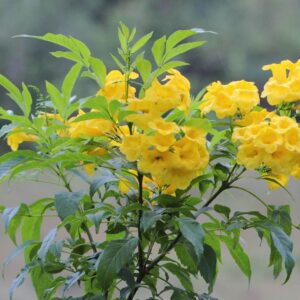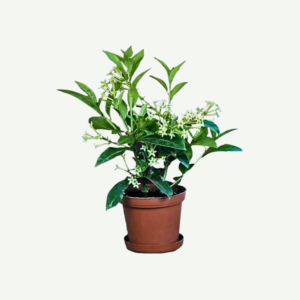Night Queen (Cestrum nocturnum), commonly known as Night-Blooming Jasmine, Night Jessamine, or Raat Rani, is a species of flowering shrub from the Solanaceae family. It is native to the tropical regions of South Asia, including India, Sri Lanka, Nepal, and Bangladesh. Night-Blooming Jasmine is widely cultivated for its highly fragrant and enchanting flowers that open and release their sweet scent during the nighttime hours.
Fragrance:
The most significant feature of Cestrum nocturnum is its enchanting fragrance. The flowers of Night-Blooming Jasmine release a powerful, sweet scent, which intensifies during the evening and nighttime hours. The fragrance is often described as rich, sweet, and reminiscent of orange blossoms.
Landscape Use:
Cestrum nocturnum is commonly grown in gardens and landscapes for its captivating fragrance and nighttime beauty.
It can be used as a specimen plant or planted in groups to create a scented garden or outdoor space.
Night-Blooming Jasmine is also suitable for container planting, allowing people to enjoy its fragrance on patios, decks, or balconies.
Note of Caution: While Night-Blooming Jasmine is valued for its fragrance, all parts of the plant, especially the berries, are considered toxic if ingested. It is essential to keep it away from children and pets and exercise caution while handling the plant.
Overall, Cestrum nocturnum (Night-Blooming Jasmine) is a cherished and delightful shrub that adds a touch of magic and allure to gardens and landscapes. Its captivating fragrance, combined with its evergreen foliage, makes it a favorite among gardeners and flower enthusiasts who appreciate the beauty and mystery of a scented night garden.
Here’s a general description of Cestrum nocturnum (Night-Blooming Jasmine):
Plant Characteristics:
Flowers: Night-Blooming Jasmine produces small, tubular, greenish-white flowers that are about 1 inch (2.5 centimeters) long. The flowers are arranged in clusters and have five spreading lobes. While the flowers themselves are not showy, their intense and captivating fragrance is the highlight of this plant.
Leaves: The leaves of Cestrum nocturnum are simple, lance-shaped, and dark green, with a smooth texture. They are arranged alternately along the stems.
Growth Habit: Night-Blooming Jasmine is a woody, evergreen shrub that can grow up to 6 to 10 feet (2 to 3 meters) in height. It has a bushy and open growth habit, with multiple stems branching out from the base.
Cultural Requirements:
Light: Cestrum nocturnum thrives in full sunlight to partial shade. It prefers bright light and warmth for optimal growth and flowering.
Temperature: This plant is well-adapted to warm and tropical climates. It is sensitive to frost and should be protected from freezing temperatures.
b Night-Blooming Jasmine requires regular watering to keep the soil consistently moist. It prefers well-draining soil but should not be overwatered or allowed to sit in waterlogged conditions.
Soil: The plant grows well in fertile, loamy soil with good drainage. It can tolerate a range of soil pH levels.
Fertilization: Regular fertilization with a balanced, diluted liquid fertilizer during the growing season (spring and summer) can promote healthy growth and flowering.






